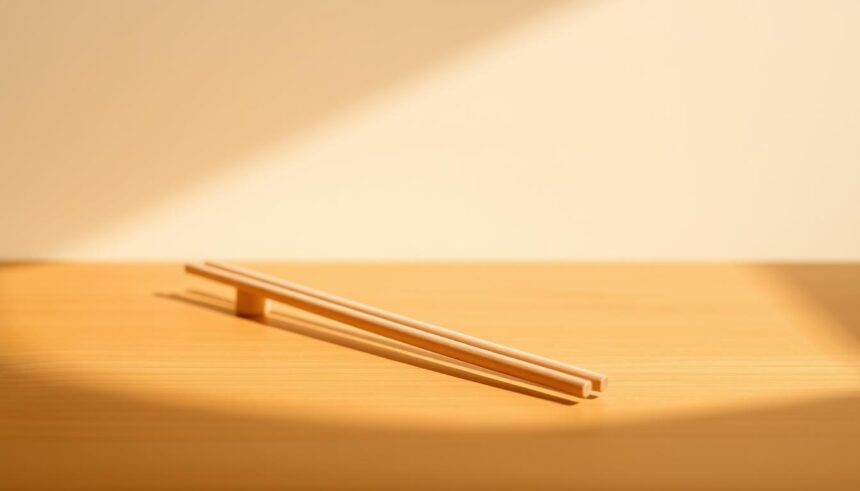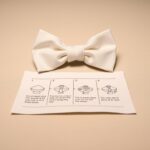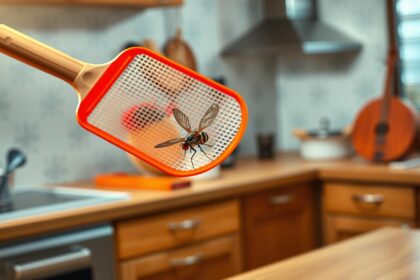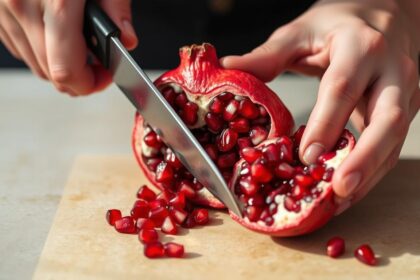You’re about to start a journey to learn how to use chopsticks. This guide will teach you the basics and more. You’ll feel confident and comfortable using this traditional utensil.
Chopsticks have a rich history and are deeply rooted in culture. They’re not just a tool; they’re a way to enjoy Asian dishes with skill. By the end of this guide, you’ll be picking up food like a pro. You’ll also learn to solve everyday problems on your own.
Key Takeaways
- Understand the history and cultural significance of chopsticks.
- Learn the proper grip and techniques for using chopsticks.
- Discover tips for picking up various foods with ease.
- Build confidence in using chopsticks for your favorite dishes.
- Enhance your dining experience with this traditional utensil.
Understanding Chopsticks: Origins and Materials
Starting your chopsticks journey? Learning about their history and materials can deepen your appreciation. Chopsticks are more than utensils; they symbolize culture, tradition, and community in Asia.
Brief History of Chopsticks
Chopsticks have been around for over 3,000 years, starting in ancient China. They began as cooking tools and later became the main eating utensil. They spread across Asia, with each culture adding its own twist.
The growth of chopsticks is linked to Asian cuisine, mainly in China, Japan, and Korea. Each culture has its own unique chopstick design, showing their dining preferences.
Types of Materials Used
Chopsticks come in various materials, each with its own perks. Here are the most common:
- Bamboo: Bamboo chopsticks are light, eco-friendly, and gentle on dishes.
- Wood: Wooden chopsticks, often from cedar or pine, can be lacquered or natural.
- Plastic: Plastic chopsticks are tough and easy to clean, great for daily use.
- Metal: Metal chopsticks, usually stainless steel or silver, are durable and elegant.
Cultural Significance
Chopsticks carry deep cultural and symbolic meanings in Asia. They’re often given as gifts for special events, like weddings and birthdays, to wish good luck and prosperity.
In many cultures, using chopsticks correctly shows respect for tradition and elders. Learning to use chopsticks is more than a skill; it’s a way to connect with a rich cultural heritage.
Anatomy of Chopsticks: Parts and Design
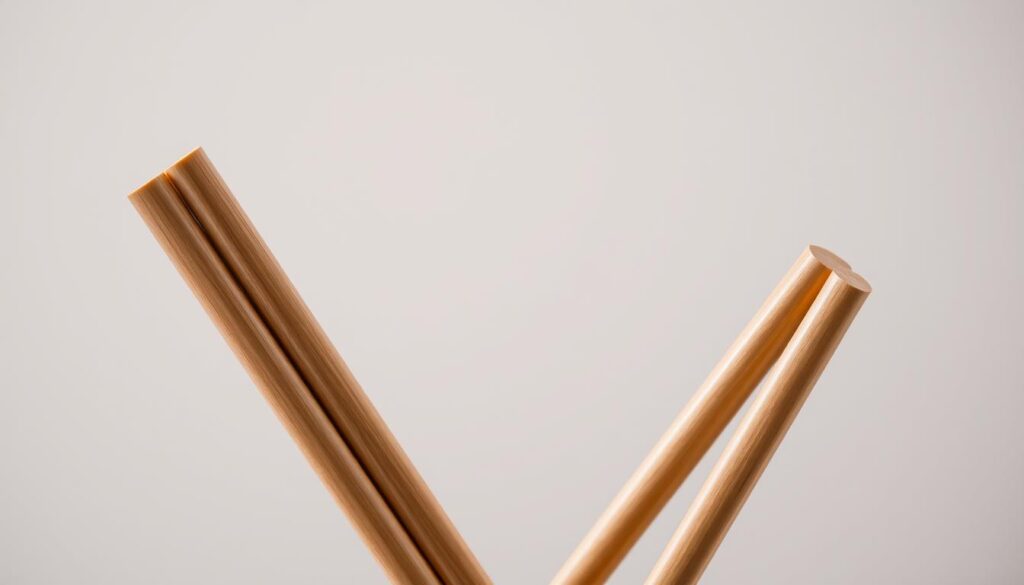
Let’s explore the parts of chopsticks to see their beauty. Knowing about their design can make eating better and more fun.
The Two Main Parts
Chopsticks have two main parts: the tip and the handle. The tip is for picking up food, and its shape can change. The handle is what you hold, and it’s thicker for comfort.
The design of these parts matters a lot. A pointed tip is precise, but a blunt tip is safer and won’t pierce food.
Different Styles and Designs
Chopsticks vary in style and design, influenced by culture, function, and looks. They can be made from wood, bamboo, plastic, or metal, each with its own feel and use.
- Bamboo and Wooden Chopsticks: These are light and feel warm. They’re great for traditional meals and are good for the environment.
- Metal Chopsticks: Common in Korean food, metal chopsticks are strong and easy to clean. They can be flat or rounded.
- Training Chopsticks: For beginners, these have a connected top to help pick up food.
Knowing about chopstick anatomy and designs helps you pick the right ones. This makes your dining experience better.
Choosing the Right Chopsticks for You
Choosing the right chopsticks is key for a great dining experience. There are many types and materials to choose from. It’s important to know what’s best for you.
Popular Options for Beginners
Beginners need chopsticks that are easy to use. Bamboo chopsticks are a top pick. They’re light, cheap, and good for the environment.
Plastic chopsticks are also great for beginners. They’re tough, easy to clean, and have a non-slip grip.
Material Choices and Their Benefits
The material of your chopsticks matters a lot. Here are some common ones and their benefits:
| Material | Benefits |
|---|---|
| Bamboo | Lightweight, eco-friendly, gentle on food |
| Stainless Steel | Durable, easy to clean, resistant to corrosion |
| Plastic | Affordable, non-slip, easy to clean |
| Wood | Aesthetic appeal, can be durable, natural feel |
Think about the food you like when picking chopsticks. For Japanese food, bamboo or wooden chopsticks are perfect. They add to the meal’s feel.
The best chopsticks for you depend on your taste, how you eat, and your favorite foods. By thinking about these, you can pick the right ones. This will make your meals better.
Proper Grip Techniques: Hold it Right
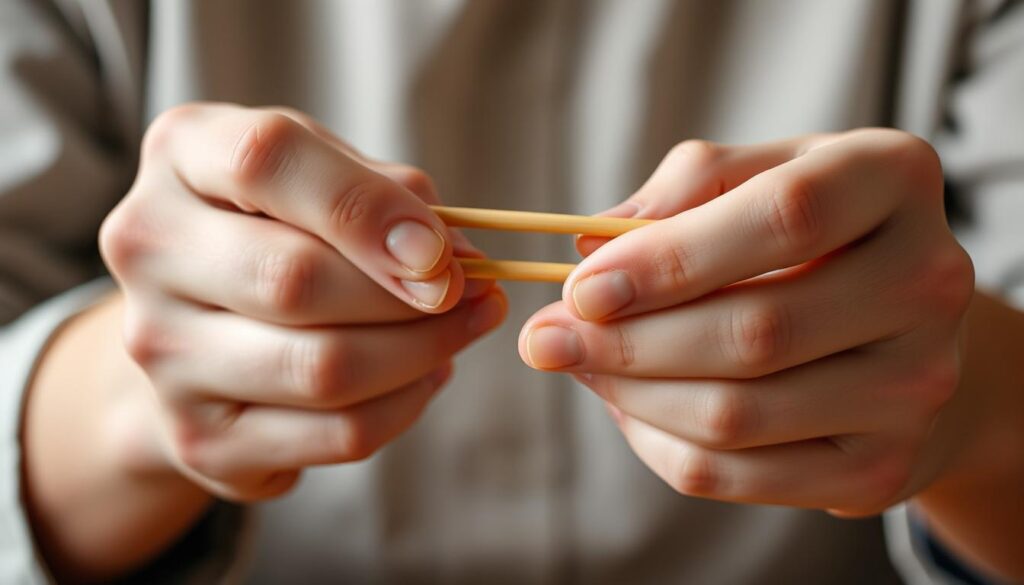
To use chopsticks well, you must first learn the right grip. Getting the grip right is key to picking up food easily and with confidence. We’ll look at two main ways to hold chopsticks: the pinch grip and the rest grip technique.
The Pinch Grip Explained
The pinch grip is a common way to hold chopsticks. Hold the top chopstick with your thumb, index finger, and middle finger. Make sure it’s secure but not too tight. The top chopstick should move freely when you pinch it. Practice is key to mastering this grip.
The Rest Grip Technique
The rest grip technique involves resting one chopstick on your thumb or between your ring finger and little finger. The other chopstick is moved with your index and middle fingers. This method is stable for picking up larger or heavier items. Experimenting with both techniques will help you find what feels natural.
Common Errors to Avoid
When learning to hold chopsticks, watch out for these common mistakes:
- Holding the chopsticks too tightly, which can lead to fatigue.
- Not keeping the chopsticks parallel, making it difficult to pick up food.
- Placing the chopsticks too far back in your hand, reducing control.
Knowing these common errors can help you adjust your grip. This will improve your chopstick-using experience.
Mastering the Basic Movement: Picking Up Food
Once you’re comfortable holding chopsticks, it’s time to practice picking up various foods. Mastering this skill is key for enjoying meals with chopsticks. We’ll guide you through lifting small items, handling larger pieces, and strategies for slippery foods.
How to Lift Small Items
Lifting small items like grains of rice or small vegetables can be tough. But with the right technique, you’ll get better. Start by placing the chopsticks right above the item you want to pick up. Then, gently squeeze the top chopstick to grasp the food. Make sure not to press too hard so the food doesn’t fly out.
- Begin with small, stationary objects like a grain of rice or a pea.
- Practice picking up the object by gently closing the chopsticks.
- Repeat this process until you can pick up the object consistently.
Techniques for Larger Pieces
For larger pieces of food, like vegetables or chunks of meat, you’ll need to adjust your technique. The key is to find the balance point of the food and grasp it firmly but gently.
- Identify the balance point of the food item.
- Position the chopsticks at this point.
- Gently close the chopsticks, ensuring a firm grip.
Strategies for Slippery Foods
Slippery foods like tofu or slices of fish can be tricky. To pick up these foods, you’ll need to be more precise and gentle. Try to grasp the food at a point that provides the most stability. Avoid applying too much pressure, which can cause the food to slip out of the chopsticks.
Tips for slippery foods:
- Choose a firmer part of the food to grasp.
- Use a gentle squeezing motion to secure the food.
- Practice with different types of slippery foods to build your confidence.
By mastering these techniques, you’ll become more confident and proficient in using chopsticks. Remember, practice is key. Don’t be discouraged by initial failures. With time, you’ll be picking up food like a pro!
Common Challenges: What to Expect as a Beginner
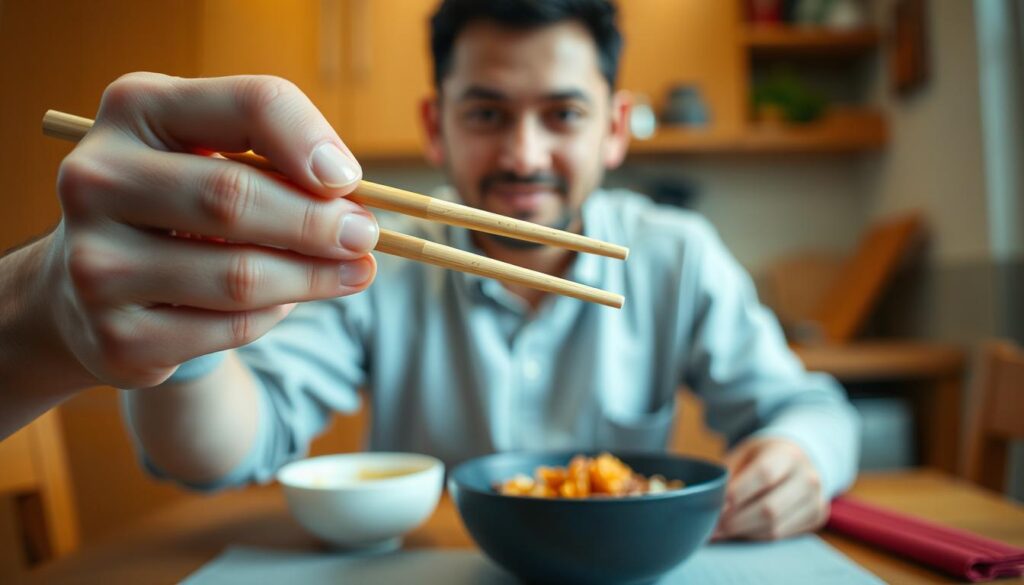
Using chopsticks might seem simple, but it can be tricky. Knowing the common challenges helps beginners overcome them. With the right tips, you’ll master chopsticks in no time.
Frustration with Grip
Many beginners struggle with frustration over their grip. It’s frustrating when your chopsticks slip or you can’t pick up food. To solve this, focus on the right grip and practice the pinch. It’s all about control and subtle movement.
Difficulty with Coordination
Coordinating chopsticks is another challenge. It takes practice to get them to work together. Start with simple tasks like picking up small objects. As you practice, your coordination will get better.
Breaking the Food
It’s common for beginners to accidentally break food while trying to pick it up. This often happens due to too much pressure or a bad grip. The solution is to be gentle yet firm. If you break food, see it as a chance to improve your technique.
By facing these challenges and practicing, you’ll get better at using chopsticks. Remember, the journey to mastering chopsticks is just as valuable as the skill itself.
Practicing with Everyday Foods
To get good at using chopsticks, practice with foods you eat every day. Using chopsticks with foods you often have makes learning easier and more fun. This way, you’ll get better at using chopsticks with each meal.
Recommended Foods for Practice
Start with foods that are easy to pick up with chopsticks. Rice, noodles, and vegetables are great for beginners. They are common in many dishes and are a good challenge. Here’s a simple table to help you choose the right foods:
| Food | Benefits for Practice |
|---|---|
| Rice | Improves precision and control |
| Noodles | Enhances grip and coordination |
| Vegetables | Develops dexterity and accuracy |
Foods to Avoid as a Beginner
It’s also key to know which foods to skip at first. Slippery foods like spaghetti or oily noodles can be tough for beginners. Also, very small or fragile foods, like tiny beans or herbs, are hard to handle. Skipping these foods will make learning easier.
Creative Practice Ideas
Make your practice sessions fun by trying new things. Try different grip styles or pick up food of different sizes. You can also practice with a friend or family member, making it a fun competition.
By making practice fun, you’ll stay motivated to keep getting better at using chopsticks.
Navigating Different Cuisines
Chopsticks are key in many Asian dishes, each with its own rules. Knowing these can make your meals better and show respect for the cultures you meet.
Using Chopsticks with Japanese Cuisine
In Japan, chopsticks have their own rules. Passing food with chopsticks is seen as rude, like a funeral act. You can lay them on a hashi-oki rest if you have one. If not, place them on the plate’s edge.
“The way you use chopsticks shows respect or disrespect,” a Japanese saying goes.
Chopsticks and Chinese Food
Chinese meals often involve sharing dishes. Use the serving chopsticks to take food from the shared dishes. Then, use your own chopsticks to eat. This keeps things clean and is seen as polite.
Taiwanese and Korean Considerations
In Taiwan, chopsticks are used like in China, with a focus on sharing. In Korea, metal chopsticks are used with a spoon. The spoon is for soups and rice, while chopsticks are for other foods.
In Korea, using both spoon and chopsticks is polite. It shows you’re skilled and respectful.
Knowing these differences helps you feel more confident in different dining places. It’s not just about how you use chopsticks. It’s also about understanding the culture you’re in.
Tips for Dining Etiquette with Chopsticks
Dining with chopsticks is more than just eating. It’s about showing respect and understanding cultural traditions. Knowing the basics of chopsticks etiquette can enhance your dining experience.
Do’s and Don’ts
Here are some key do’s and don’ts for using chopsticks:
- Do hold your chopsticks correctly. The upper one goes between your thumb and index finger. The lower one goes between your middle and ring finger.
- Don’t leave your chopsticks standing upright in your rice. This is seen as rude in some Asian cultures.
- Do pass dishes with both hands as a sign of respect. But don’t pass the chopsticks themselves.
- Don’t cross your chopsticks or point them at someone. This can be seen as aggressive.
How to Handle Chopsticks in Public
Using chopsticks in public requires finesse and cultural awareness. Here are some tips:
- Hold your chopsticks firmly but gently.
- When not using them, place them on the chopstick rest. If there’s no rest, lay them across the plate’s edge.
- Avoid making loud noises with your chopsticks. Clicking them against the plate or bowl is not polite.
- Be respectful when dining with others. It’s okay to ask for help if you’re unsure.
By following these tips, you can enjoy dining with chopsticks while showing respect for cultural traditions.
Fun Facts about Chopsticks
Get ready to learn some cool facts about chopsticks. They’re not just tools; they’re a big part of a long history and many cultures.
Trivia to Impress Friends
Did you know chopsticks started over 3,000 years ago in China? They were first for cooking, not eating. Their history is rich, with the Shang Dynasty being the first recorded use.
The first chopsticks were made from bronze. This fact will surely impress your friends.
Chopsticks vary a lot by culture. Japanese ones are shorter and more pointed, often made from bamboo.
Unique Uses Around the World
Chopsticks are more than just for eating. In some places, they’re used in big ceremonies like weddings. They’re also given as gifts, meaning good luck and wealth.
Artists use chopsticks to make sculptures and decorations. You might be surprised to learn they can mark plants or decorate homes.
Fun Cultural References
Chopsticks have appeared in movies, TV, and games. They symbolize Asian culture or play a key role in stories.
In Japan, using chopsticks in rice the wrong way is rude. It reminds them of funerals. Knowing these customs shows you value the cultures behind chopsticks.
Conclusion: Enjoying the Journey to Mastery
Learning to use chopsticks is a journey that needs patience, practice, and a positive attitude. You’ve learned the basics, like where chopsticks come from and how to hold them. But there’s more to it.
Practicing with Confidence
To get better, work on feeling confident with chopsticks. Practice with different foods often. Don’t get upset if it’s hard at first. With time, you’ll get better and more comfortable.
Exploring Further Resources
For more learning, check out online tutorials, cooking classes, or events about Asian food. These can help you understand and enjoy chopstick culture more.
Keep going on your chopstick journey. It’s not just about learning a new skill. It’s about connecting with a rich cultural heritage. Stay committed, and soon you’ll be enjoying your favorite Asian dishes with ease.


